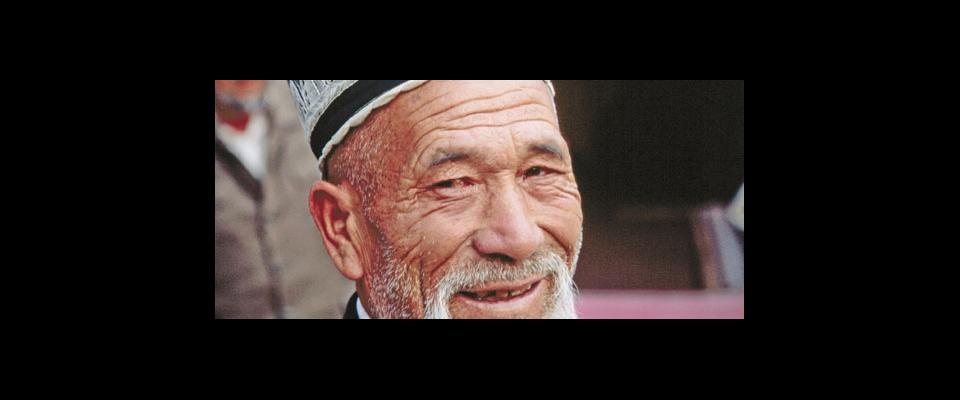Hundreds of miles west of the Great Wall, amid desert camels and canvas-covered yurts, it’s natural to wonder: “Can I really be in China?”
Geography can play tricks with you on a modern journey along the ancient Silk Road. On one day in the exotic city of Kashgar, the wooden doors of a concealed family compound opened and a young woman, her head covered in a long purple scarf, her arms cradling a baby girl, welcomed me, the stranger, to enter what had seemed a forbidden precinct. Without guile or intrigue she offered a cup of jasmine tea, as is Islamic custom. Here, within this private garden, a stone courtyard dominated by an expansive date palm provided protection from the rising heat. Inside a formal reception area adorned with Ottoman arches carved into the whitewashed walls, stacks of vivid red-and-black carpets were piled across the floor.
Returning to the street outside, I heard lilting Arab music coming from a portable radio. Construction workers were patiently padding straw and clay between layers of new brick, proving that this ancient urban compound was not without new life. A few moments later, in a bustling commercial district, I watched teenaged apprentices learn how to fashion knives, swords, and metal skewers by clanging metal hammers across heated steel bars, then grinding the bars against foot-cranked bladed wheels as sparks danced and burst around them. Bearded men offered sesame bagels, still warm, and wide ovals of naan ready to be packed with morsels of lamb kebab.
More than once in a two-week journey crossing thousands of miles—from a canvas—covered yurt in a mountain preserve where horses and sheep graze and the language sounds straight out of Tolstoy, to a desert encampment where visitors can take camels out along rising sand dunes, to an incredible series of caves hidden in sandstone and displaying Buddhist carvings more than 2,500 years old—I wondered aloud, “Can I really be in China?”
The term “Silk Road” conjures images of Marco Polo’s journey to the ancient capital of Chang’an, now Xi’an. Today thousands of terra cotta warriors still stand guard there over an ancient tomb of the first Qin Emperor, attracting thousands of visitors each day. Hundreds of miles west from the Great Wall, treacherous routes carried traders on the backs of camels and horses around enormous swaths of the Taklamakan and Lop Deserts. The Silk Road’s ancient system of trails and oases (rather than a single, unified route) brought silk, invented by the Chinese, to the Emperor of Rome, who became enamored of such light and colorful fabrics. The return trip brought Persian carpets, Buddhist teaching, and Islamic influence into what is now the Xinjiang region, or “New Frontier” territories, of modern China.
It is more than 2,000 miles from the teeming metropolis of Beijing to the ancient oasis of Kashgar, which lies only about 250 miles along the Karakoram highway from the Afghan capital, Kabul. Indeed, the cultural links connecting Kashgar and the Chinese capital seem rather tenuous. The glistening domes of the city’s mosques, the night markets that offer only halal food, and the headscarves donned by most women in public all demonstrate that Islamic culture prevails in Kashgar. Starbucks and karaoke bars aren’t in favor here as they are on the coast. And the city’s enormous bazaar reflects its long history, offering huge varieties of silk and carpets, as well as local crafts such as copper teapots and wooden jewelry boxes, and, on weekends, horses.
Desolate, enormous—some three times the size of France—and rich in oil, precious metals, and other resources, the far-flung Xinjiang Autonomous Region of China could be considerd as China’s own Alaska. Comprising such vastly different cultures, it’s no wonder that integrating and controlling this contested region has, since ancient times, challenged the political leadership in the far-off capital, which endured centuries of debates over whether to annex the region or distance itself from it.
Ultimately, the mandarinate determined that at least loose control offered the best protection from the destabilizing influences of the Central Asian steppes. Perhaps that’s why a 40-foot statue of a waving Mao Zedong, one of the largest still standing in China, presides watchfully over Kashgar’s People’s Park in the center of the city. From his perch, Mao can serenely observe the morning Tai Ch’i exercises conducted by a few dozen Han Chinese, clad in silky white polyester, while the Muslim majority of Kashgar ride bicycles and scooters off to work, seemingly oblivious. Not far away stands the enormous yellow-tile Id Kah mosque, complete with towering minarets, which can accommodate as many as 20,000 visitors during important holidays.
Another form of central control: All government services, including trains and buses, run on “Beijing time,” even though the sun rises two hours later out here in the west; as if Washington, D.C., time were imposed on Colorado. The ethnic Uighurs, though, open their shops and make plans to meet friends on “local time.” After September 11, 2001, China suggested that its Uighur-speaking minority, which dominates cities such as Kashgar and the provincial capital of Urumqi, might harbor Islamist terrorists and appealed for Western “understanding” as it sought to crack down on separatist aspirations. Today, Beijing encourages Han Chinese from the crowded eastern areas to head west and repopulate this region so as to undermine Muslim control. In turn, the government offers economic and other incentives for the best and brightest residents of its westernmost province to pursue advanced degrees and economic opportunities in the capital or on the coasts. “The best jobs and the best schools aren’t here,” one local Uighur, who has plans to emigrate, told me. “The government wants you to leave. Ultimately, they’d want a Han Chinese to replace you.”
If Kashgar demonstrates the strong cultural legacy bestowed by the Islamic world on China, the impact of India is best captured at another oasis that sprouts improbably from the desert along the Silk Road: the enormous complex of caves carved into the sandstone hills outside Dunhuang. The Mogao Grottoes, or “Caves of a Thousand Buddhas,” rise up inconspicuously from a narrow streambed surrounded by poplar trees, like terraced apartments built by some enterprising developer of the 4th century. The waters of this modest stream were a lifeline for those trekking through the Gobi Desert, and the caves were repositories for travelers’ prayers of divine providence. The grottoes are thought to have been inspired by the vision of a local monk, Yue Zhung, who woke one day with a fevered vision of a thousand Buddhas holding court.
Today the network of 492 temples has been unearthed, catalogued, and opened on a limited basis to the public. These mysterious caves, often visible only by flashlight, display enormous and powerfully evocative Buddhas, many sheathed in gold leaf, the largest more than 100 feet tall. Other temples resemble Chinese-style pavilions with gilded roofs, statuaries of powerful horses, and Buddhist frescoes. Some caves are filled with thousands of tiny, individual Buddhas painted on the walls, each surrounded by a nimbus of gold. It is staggering to calculate how many years it took to complete such reverent paintings.
Guides here are quick to remind foreign visitors of the systematic looting of these treasures that took place early in the 20th century. The most notable thief was probably the Hungarian-born linguist Sir Aurel Stein, who uncovered tens of thousands of ancient documents that he later described as a “solid mass of manuscript bundles rising to the height of nearly ten feet.” Many of these canonical texts, written in Sanskrit, Sogdian, Brahmi, and Tibetan, among other ancient languages, were ferreted off to the British Museum,
along with precious frescoes and carvings. Naturally, the Chinese would like their treasures back.
Persia’s deep influence on the Chinese personality sneaks up on us only days later as we wander through the strikingly modern new Shanghai Museum. Despite its sleek interiors and sophisticated displays, the museum was designed to resemble a traditionally Chinese cooking tripod, or ding, with a round top and a square base. Amid an impressive array of ancient bronzes and yet more Buddhist sculptures, I was brought up short in the ceramics gallery by a tall white-and-blue pitcher with a robust spout from Jingdezhen, the capital of porcelain in the Ming period of the 15th century. This stunning design displays a series of interlaced flowers and delicately imagined long, circular stems that might as well have been lifted directly from a Persian carpet. Clearly its provenance is Chinese—yet it remains stubbornly un-Chinese as well.
Likewise, the modern Silk Road is now a part of China, but one that stubbornly reminds us that the forces shaping history and civilizations are complex and more subtle than we sometimes care to recognize. These ancient forces may not be readily visible in the shopping districts of coastal Shanghai, but they remain an essential part of the distinctive character of this diverse and complex nation.




















